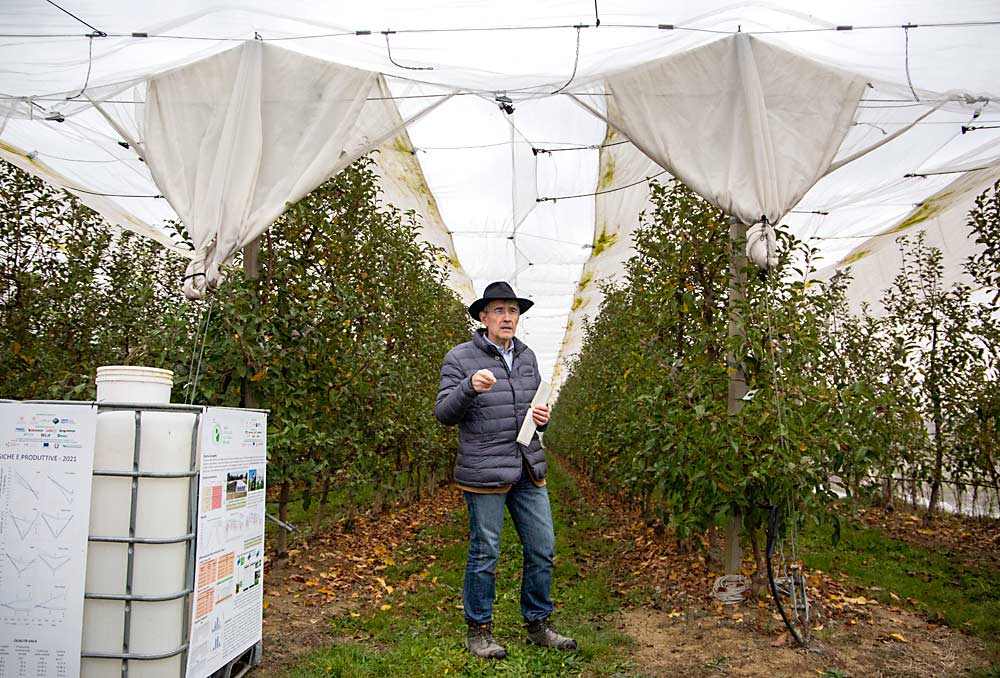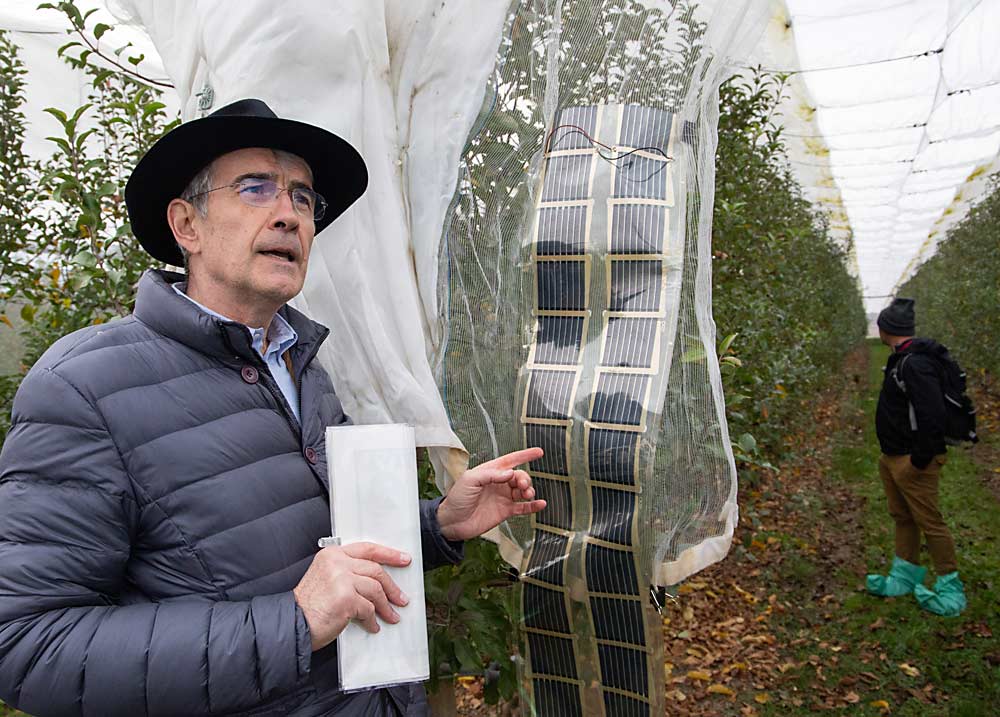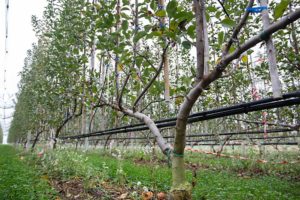
At the world’s oldest continuously operating university, an Italian researcher is using netting and the Internet of Things to halve an apple orchard’s water consumption and hopes to someday power his robotic tractor with solar energy harnessed from above the canopy.
Luca Corelli Grappadelli, a tree fruit physiologist at the University of Bologna, cut water delivery in two apple blocks to half their usual allotment under a combination of rain covers, insect exclusion netting and hail netting, with no drop in productivity or fruit quality, he said.
“We need to really start doing things in the face of climate change, where we drastically reduce the water consumption of an orchard,” he said in November during the International Fruit Tree Association, or IFTA, tour of Italian growing areas.
Drought was a recurring topic in Italy. Some rivers recently experienced two years of historic water shortages, and Bologna — capital of the Emilia-Romagna region — is not immune, Corelli Grappadelli said. The area receives a lot of rain, but it comes in downpours, and agricultural producers don’t have the infrastructure to capture it. July weather in Bologna is even a little warmer than that of Wenatchee, Washington.
Netting also is common in Italy, covering hillside orchards to the horizons in some places. But it is usually for hail protection.
In North America, especially the arid West, growers use netting to prevent sunburn, not typically to conserve water. At least, not yet, said Greg Lang, a Michigan State University horticulturist who previously worked at Washington State University.
“Anything with growers, they focus on the initial problem at hand,” said Lang, an IFTA board member who helped organize the University of Bologna visit.
Lang sees a similar pattern with labor-saving tools. European growers felt the pinch of workforce shortages earlier than their American colleagues and naturally adopted platforms sooner, he said. But U.S. and Canadian growers eventually felt the same need and made the same moves.
Now that California growers have faced several years of severe drought, he suspects netting will become popular for its water conservation properties, as well as its shade and rain protection properties.
Bologna’s netting trials
In Italy, Corelli Grappadelli’s netting combination reduced sunlight, which reduced temperature and photoinhibition of photosynthesis, as trees must repair more sun damage under excessive sunlight. It also increased relative humidity and decreased the vapor pressure deficit — the difference between fruit relative humidity and air relative humidity.
“We basically had yields for two years with the water for one year,” he said.
The trial is part of the S3O, or Smart Specialized Sustainable Orchard, a collaborative project between the university and other research institutions in Italy. The project also tracks diseases and pests.
The rain covers help reduce apple scab. Researchers used a solid-set spray system to apply fungicide every Friday, to make re-entry more convenient. If it rained on a Saturday, scab got a week’s head start. Still, the netting cut down on scab incidence by reducing leaf wetting, he said.
Researchers tried installing photovoltaic panels to the netting to harness solar energy, but the water seeped between plastic sheets and ruined them. They plan to try again. Their goal is to power an electric robotic tractor developed by the university and now commercialized as Field Robotics.

That part of the experiment will be proof-of-concept only, Corelli Grappadelli said. Outfitting orchards with solar panels would cost about $240,000 per acre, an investment only a utility company could afford. Laws allow it only if the productivity of the orchard does not suffer, he said.
Meanwhile, the solar arrays may not be allowed in South Tyrol, Italy’s most productive apple region, where the appearance of orchards is regulated by local laws.
Photovoltaics aside, the net setup works for saving water, at least on apples in his region, he said.
“If you are growing apples, and you need to save water, this is a configuration that’s worth trying,” he said. “All these materials are commercially available.”
He warned against using the method for stone fruit. It would be a “disaster,” he said. Unlike apples, peaches lose water during the heat of the day to make it easier for the tree to move carbohydrates to fruit. They need the vapor pressure deficit. Water-saving covers lower that deficit, which in turn limits fruit growth and color development.
He also cautioned against using netting for apples anywhere else without some independent research. Bologna’s soils are rich and loamy, leading to ample vigor for M.9 rootstocks. His crews probably fertilized with nitrogen only twice the entire 12 years of the orchard’s life. Reducing light may affect trees differently in South Tyrol and various regions of North America, he said.
“We had decades of photosynthetic measurements, so we knew we could cut water by half,” he said.
—by Ross Courtney







Leave A Comment